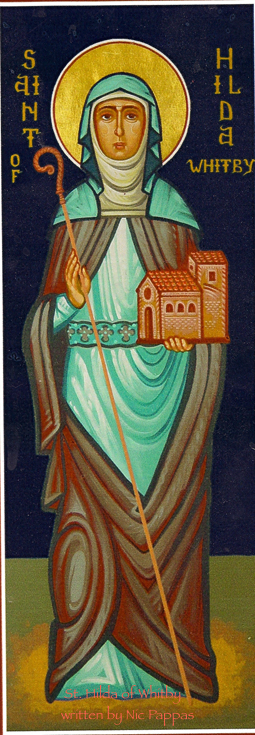Father James Martin in his book, My Life with the Saints describes saints as simply being “friends on the other side.” For this lifelong Protestant, this was eye-opening, mind-bending, and soul-expanding good news. Father Martin’s words allowed both mind and soul to intersect and to assimilate the idea that I could experience and embrace Celtic and Anglo-Saxon saints as friends on the other side.
While working on the Master of Divinity degree in a seminary where women are trained that they are not allowed to become pastors or teachers of males, discovering St. Hilda (Hild) of Whitby in a History of Christianity course was both life-changing and liberating. When the professor taught about the Celtic and Catholic gathering of minds concerning some theological issues at St. Hilda’s double monastery for the Synod of Whitby in 664 AD in Northeast England, I was both stunned and elated to learn that this synod was held at a double monastery under the authority of an Abbess named Hilda. Wow, that was life-altering news that a woman in history had been in spiritual and vocational leadership over both women and men.
Curiosity got the best of this former librarian and I began chasing Hilda by reading everything I could find on her and I knew that I must travel to those places where she had lived and served. Bede’s Ecclesiastical History of the English People became my bible of sorts as I began this unexpected journey of chasing Hilda and her Celtic and Anglo-Saxon friends. Just as the Synod of Whitby held at St. Hilda’s monastery was a watershed moment in the Celtic Church, it was for me also.
My spouse who is a fellow pilgrim in life travelled with me on our first journey of chasing Hilda. We arrived in Northeast England in February and stayed in Ampleforth Abbey as we thought it was close to Whitby. While staying in this stunningly beautiful and historical English Benedictine Abbey, we excitedly told a monk at breakfast that we were headed to Whitby for the day. Almost instantaneously, we received a message from the Abbot that he would not allow us to go to Whitby as the curving, narrow icy roads were too treacherous. My husband and I still muse that this was our first encounter with the power of Abbots. Later on during the week when the snow and ice melted, we finally made our pilgrimage to Whitby where we wandered in wonderment through the mystical grounds and magnificent museum. We were really in the very place where St. Hilda had resided and had developed this coastal land into an Abbey that made a significant mark on Christian history.
Back at home, while gazing upon my first icon of St. Hilda of Whitby, I sensed that she was telling me, “get thee to Lindisfarne.” Yes, she spoke in Old English. I explained to my spouse that we should go to Lindisfarne and somehow he trusted that Celtic command. I had no clue where Lindisfarne was, but had read about it in reference to Aidan’s call to Hilda to become an Abbess. Two weeks later, we were once again chasing Hilda by plane and a little coracle of a car to Lindisfarne, also known as Holy Island where the magnificent early 8th c. handwritten and illuminated Lindisfarne Gospels was produced. Yes, Hilda was correct, I did need to go to Lindisfarne as it provided the background information to better understand the Celtic and Anglo-Saxon saints.
Throughout the past fifteen years of chasing Hilda on numerous pilgrimages to Lindisfarne; Whitby; Hartlepool; Hackness; Monkwearmouth; St. Hilda’s South Shields Church; Hinderwell; and even modern day St. Hilda’s Priory in Whitby, it has been an enriching experience of discovery, faith, and transformation. Visiting and praying in ancient Celtic monastic sites and in churches etched with a millennia of prayers associated with St. Hilda have all enriched my love and admiration for this courageous and wise woman of vision and faith. Studying about Hilda’s family and especially her sister, Queen Hereswith, has also led to further journeys in East Anglia and Central France east of Paris including Chelles, Faremoutiers, and Jouarre.
In 2013, for an Advent spiritual discipline, I composed a daily devotional on the Celtic and Anglo-Saxon saints entitled, “Celts to the Creche” that became part of my Saintsbridge blog. It continues to be a delightful and humbling surprise that people from around the world are also interested in these saints and read these posts.
Chasing Hilda has gloriously grown new friendships in both the U.S. and the U.K. with those who also have a passion for St. Hilda and the Celtic and Anglo-Saxon saints. Thank you St. Hilda for being a friend on the other side and as I chased you, I think you may have been chasing me also.
*If you would like further information on St. Hilda of Whitby, please follow this link: http://saintsbridge.org/2013/12/01/st-hilda-of-whitby/


2 comments
[…] on my first encounter with St. Hilda entitled, “Chasing Hilda” has been published on Godspace. https://godspacelight.com/2016/07/23/chasing-hilda/. I am delighted that Godspace is hosting a month long study on Celtic Christianity. I hope you will […]
[…] Brenda Griffin. “Chasing Hilda.” July 23, 2016. […]